Accounting Financial Analysis Report - University Assignment
VerifiedAdded on 2020/02/24
|6
|984
|89
Report
AI Summary
This accounting financial analysis report examines the crucial role of liabilities in business operations and their impact on financial statements. It defines liabilities, discusses recognition criteria, and explores the consequences of failing to accurately capture liability information. The report highlights how improper recognition can lead to profit overstatement and misinform stakeholders like creditors, shareholders, and potential investors. It emphasizes the importance of fair value accounting and the effects of incorrect liability valuation on liquidity ratios and management decision-making. The report also differentiates between current and non-current liabilities and their implications, concluding that accurate liability recognition is essential for reliable financial reporting and informed decision-making. This assignment is designed to provide students with a clear understanding of how liabilities affect financial statements and profit.
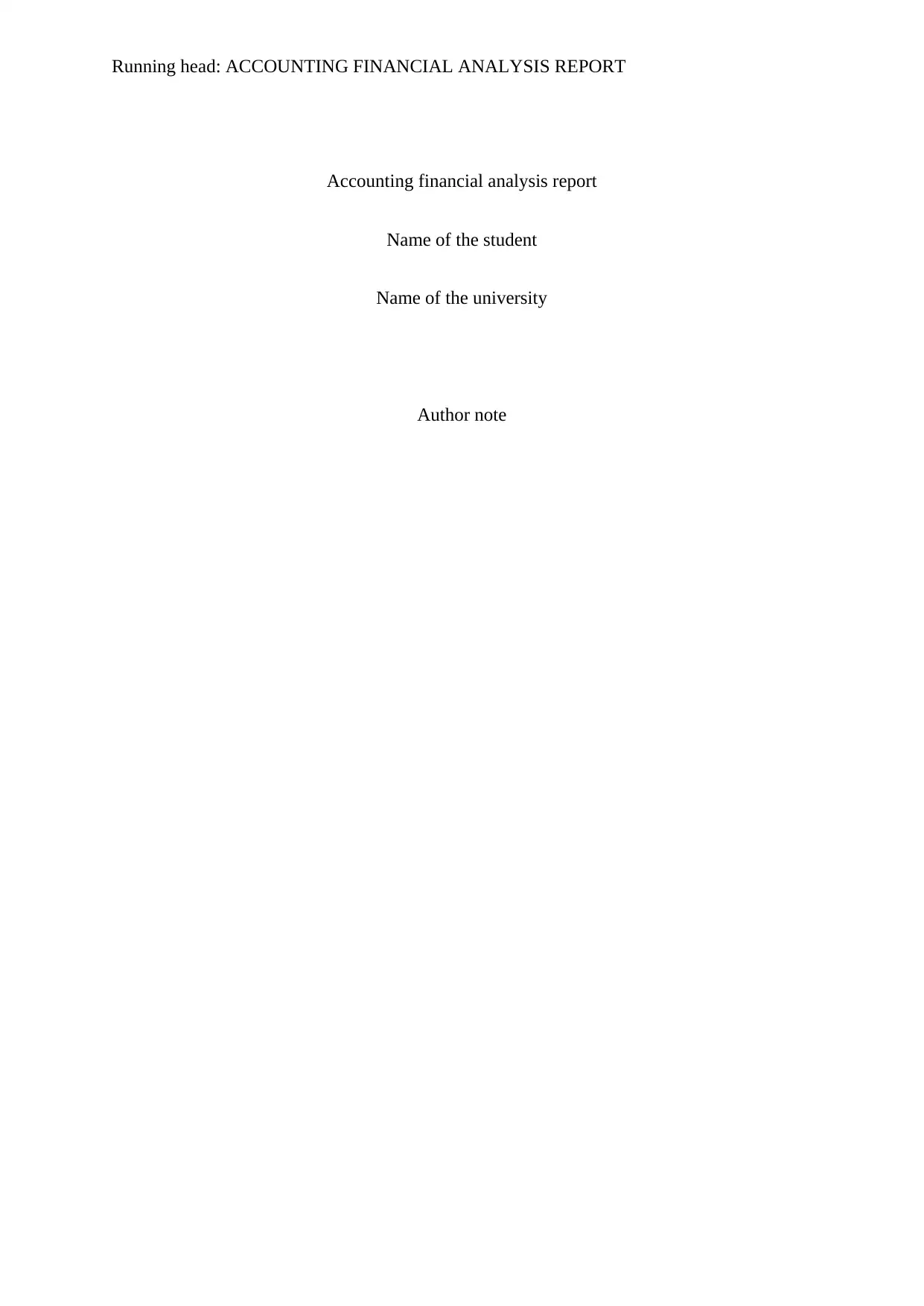
Running head: ACCOUNTING FINANCIAL ANALYSIS REPORT
Accounting financial analysis report
Name of the student
Name of the university
Author note
Accounting financial analysis report
Name of the student
Name of the university
Author note
Paraphrase This Document
Need a fresh take? Get an instant paraphrase of this document with our AI Paraphraser
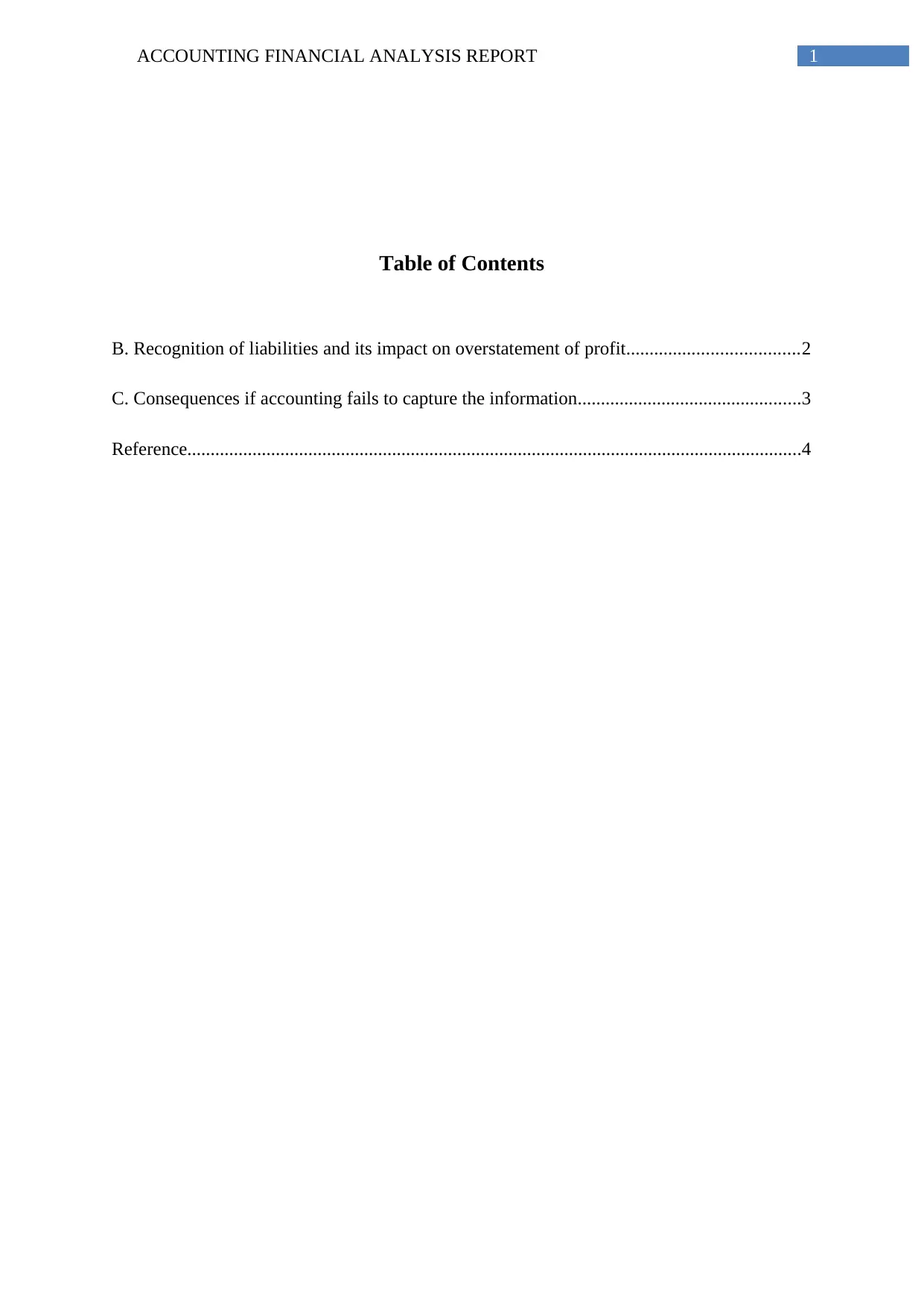
1ACCOUNTING FINANCIAL ANALYSIS REPORT
Table of Contents
B. Recognition of liabilities and its impact on overstatement of profit.....................................2
C. Consequences if accounting fails to capture the information................................................3
Reference....................................................................................................................................4
Table of Contents
B. Recognition of liabilities and its impact on overstatement of profit.....................................2
C. Consequences if accounting fails to capture the information................................................3
Reference....................................................................................................................................4
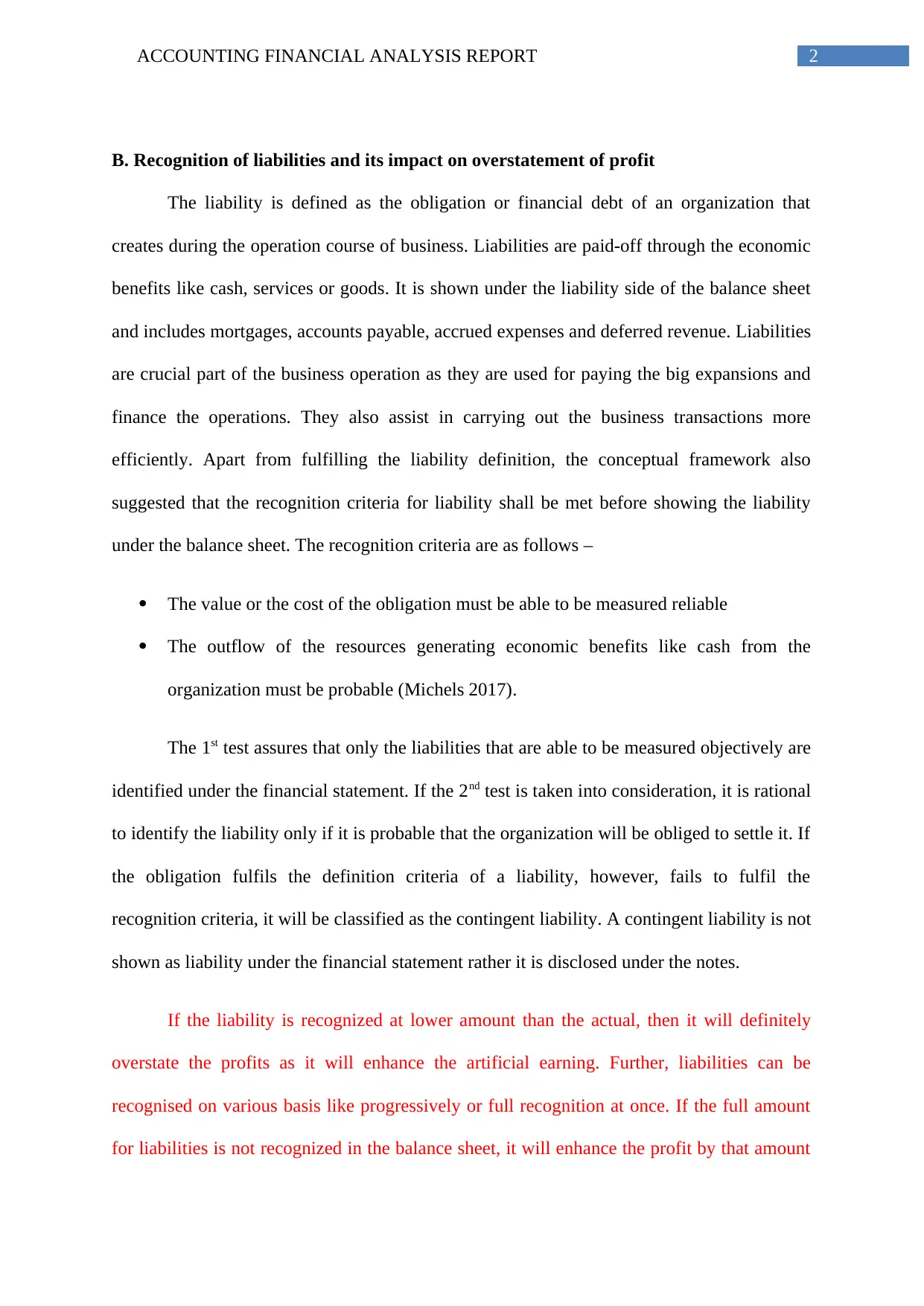
2ACCOUNTING FINANCIAL ANALYSIS REPORT
B. Recognition of liabilities and its impact on overstatement of profit
The liability is defined as the obligation or financial debt of an organization that
creates during the operation course of business. Liabilities are paid-off through the economic
benefits like cash, services or goods. It is shown under the liability side of the balance sheet
and includes mortgages, accounts payable, accrued expenses and deferred revenue. Liabilities
are crucial part of the business operation as they are used for paying the big expansions and
finance the operations. They also assist in carrying out the business transactions more
efficiently. Apart from fulfilling the liability definition, the conceptual framework also
suggested that the recognition criteria for liability shall be met before showing the liability
under the balance sheet. The recognition criteria are as follows –
The value or the cost of the obligation must be able to be measured reliable
The outflow of the resources generating economic benefits like cash from the
organization must be probable (Michels 2017).
The 1st test assures that only the liabilities that are able to be measured objectively are
identified under the financial statement. If the 2nd test is taken into consideration, it is rational
to identify the liability only if it is probable that the organization will be obliged to settle it. If
the obligation fulfils the definition criteria of a liability, however, fails to fulfil the
recognition criteria, it will be classified as the contingent liability. A contingent liability is not
shown as liability under the financial statement rather it is disclosed under the notes.
If the liability is recognized at lower amount than the actual, then it will definitely
overstate the profits as it will enhance the artificial earning. Further, liabilities can be
recognised on various basis like progressively or full recognition at once. If the full amount
for liabilities is not recognized in the balance sheet, it will enhance the profit by that amount
B. Recognition of liabilities and its impact on overstatement of profit
The liability is defined as the obligation or financial debt of an organization that
creates during the operation course of business. Liabilities are paid-off through the economic
benefits like cash, services or goods. It is shown under the liability side of the balance sheet
and includes mortgages, accounts payable, accrued expenses and deferred revenue. Liabilities
are crucial part of the business operation as they are used for paying the big expansions and
finance the operations. They also assist in carrying out the business transactions more
efficiently. Apart from fulfilling the liability definition, the conceptual framework also
suggested that the recognition criteria for liability shall be met before showing the liability
under the balance sheet. The recognition criteria are as follows –
The value or the cost of the obligation must be able to be measured reliable
The outflow of the resources generating economic benefits like cash from the
organization must be probable (Michels 2017).
The 1st test assures that only the liabilities that are able to be measured objectively are
identified under the financial statement. If the 2nd test is taken into consideration, it is rational
to identify the liability only if it is probable that the organization will be obliged to settle it. If
the obligation fulfils the definition criteria of a liability, however, fails to fulfil the
recognition criteria, it will be classified as the contingent liability. A contingent liability is not
shown as liability under the financial statement rather it is disclosed under the notes.
If the liability is recognized at lower amount than the actual, then it will definitely
overstate the profits as it will enhance the artificial earning. Further, liabilities can be
recognised on various basis like progressively or full recognition at once. If the full amount
for liabilities is not recognized in the balance sheet, it will enhance the profit by that amount
⊘ This is a preview!⊘
Do you want full access?
Subscribe today to unlock all pages.

Trusted by 1+ million students worldwide
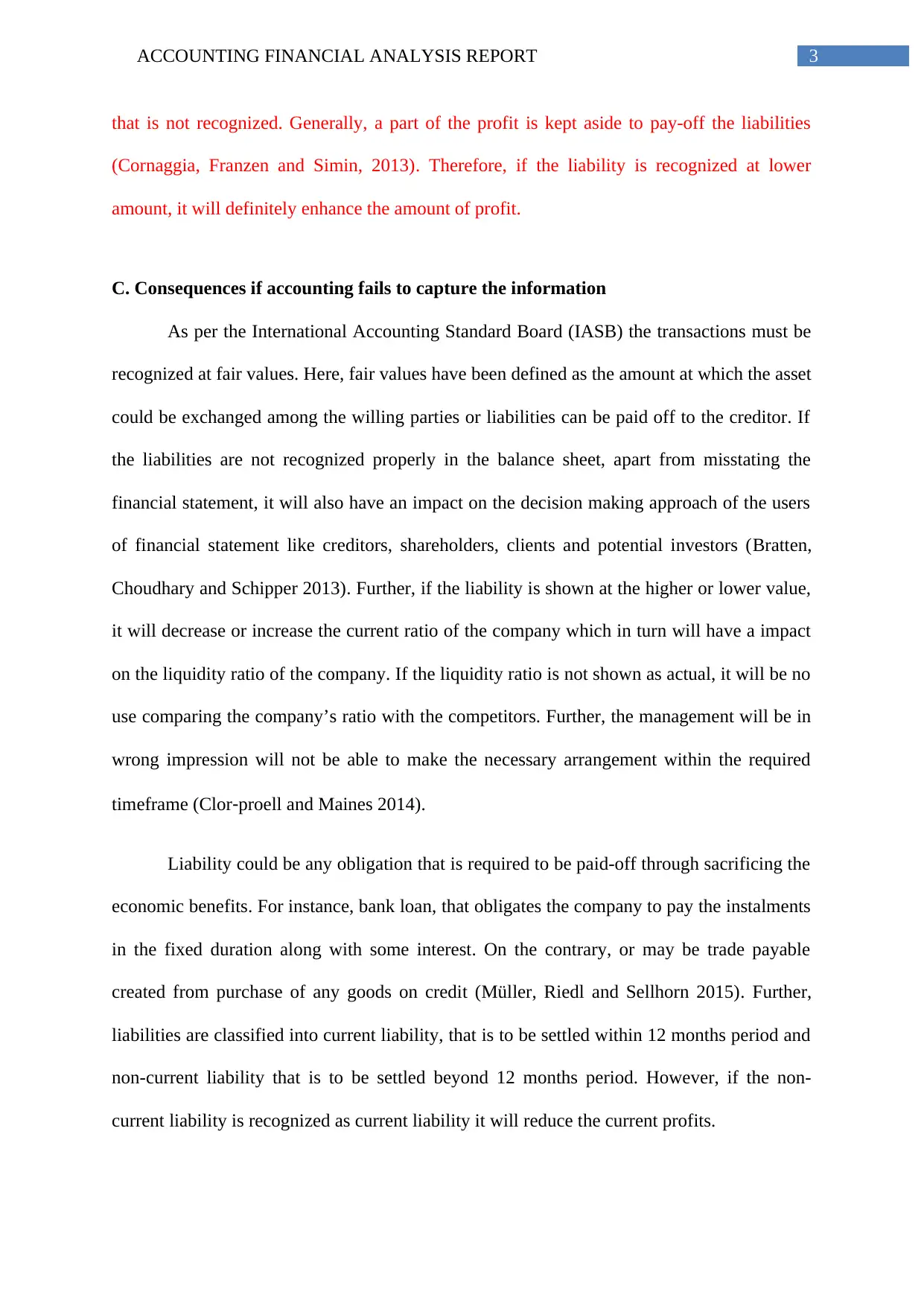
3ACCOUNTING FINANCIAL ANALYSIS REPORT
that is not recognized. Generally, a part of the profit is kept aside to pay-off the liabilities
(Cornaggia, Franzen and Simin, 2013). Therefore, if the liability is recognized at lower
amount, it will definitely enhance the amount of profit.
C. Consequences if accounting fails to capture the information
As per the International Accounting Standard Board (IASB) the transactions must be
recognized at fair values. Here, fair values have been defined as the amount at which the asset
could be exchanged among the willing parties or liabilities can be paid off to the creditor. If
the liabilities are not recognized properly in the balance sheet, apart from misstating the
financial statement, it will also have an impact on the decision making approach of the users
of financial statement like creditors, shareholders, clients and potential investors (Bratten,
Choudhary and Schipper 2013). Further, if the liability is shown at the higher or lower value,
it will decrease or increase the current ratio of the company which in turn will have a impact
on the liquidity ratio of the company. If the liquidity ratio is not shown as actual, it will be no
use comparing the company’s ratio with the competitors. Further, the management will be in
wrong impression will not be able to make the necessary arrangement within the required
timeframe (Clor‐proell and Maines 2014).
Liability could be any obligation that is required to be paid-off through sacrificing the
economic benefits. For instance, bank loan, that obligates the company to pay the instalments
in the fixed duration along with some interest. On the contrary, or may be trade payable
created from purchase of any goods on credit (Müller, Riedl and Sellhorn 2015). Further,
liabilities are classified into current liability, that is to be settled within 12 months period and
non-current liability that is to be settled beyond 12 months period. However, if the non-
current liability is recognized as current liability it will reduce the current profits.
that is not recognized. Generally, a part of the profit is kept aside to pay-off the liabilities
(Cornaggia, Franzen and Simin, 2013). Therefore, if the liability is recognized at lower
amount, it will definitely enhance the amount of profit.
C. Consequences if accounting fails to capture the information
As per the International Accounting Standard Board (IASB) the transactions must be
recognized at fair values. Here, fair values have been defined as the amount at which the asset
could be exchanged among the willing parties or liabilities can be paid off to the creditor. If
the liabilities are not recognized properly in the balance sheet, apart from misstating the
financial statement, it will also have an impact on the decision making approach of the users
of financial statement like creditors, shareholders, clients and potential investors (Bratten,
Choudhary and Schipper 2013). Further, if the liability is shown at the higher or lower value,
it will decrease or increase the current ratio of the company which in turn will have a impact
on the liquidity ratio of the company. If the liquidity ratio is not shown as actual, it will be no
use comparing the company’s ratio with the competitors. Further, the management will be in
wrong impression will not be able to make the necessary arrangement within the required
timeframe (Clor‐proell and Maines 2014).
Liability could be any obligation that is required to be paid-off through sacrificing the
economic benefits. For instance, bank loan, that obligates the company to pay the instalments
in the fixed duration along with some interest. On the contrary, or may be trade payable
created from purchase of any goods on credit (Müller, Riedl and Sellhorn 2015). Further,
liabilities are classified into current liability, that is to be settled within 12 months period and
non-current liability that is to be settled beyond 12 months period. However, if the non-
current liability is recognized as current liability it will reduce the current profits.
Paraphrase This Document
Need a fresh take? Get an instant paraphrase of this document with our AI Paraphraser
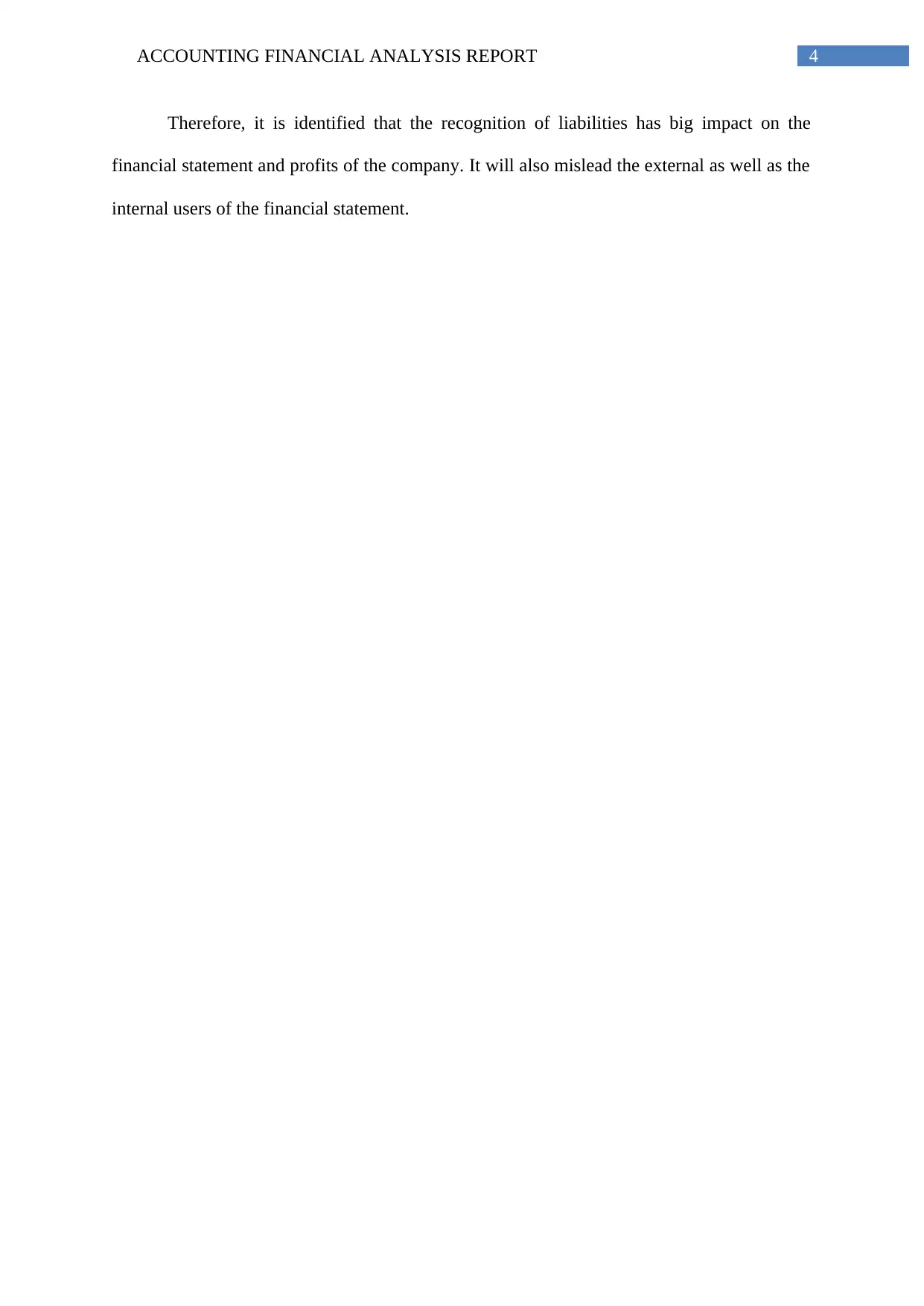
4ACCOUNTING FINANCIAL ANALYSIS REPORT
Therefore, it is identified that the recognition of liabilities has big impact on the
financial statement and profits of the company. It will also mislead the external as well as the
internal users of the financial statement.
Therefore, it is identified that the recognition of liabilities has big impact on the
financial statement and profits of the company. It will also mislead the external as well as the
internal users of the financial statement.
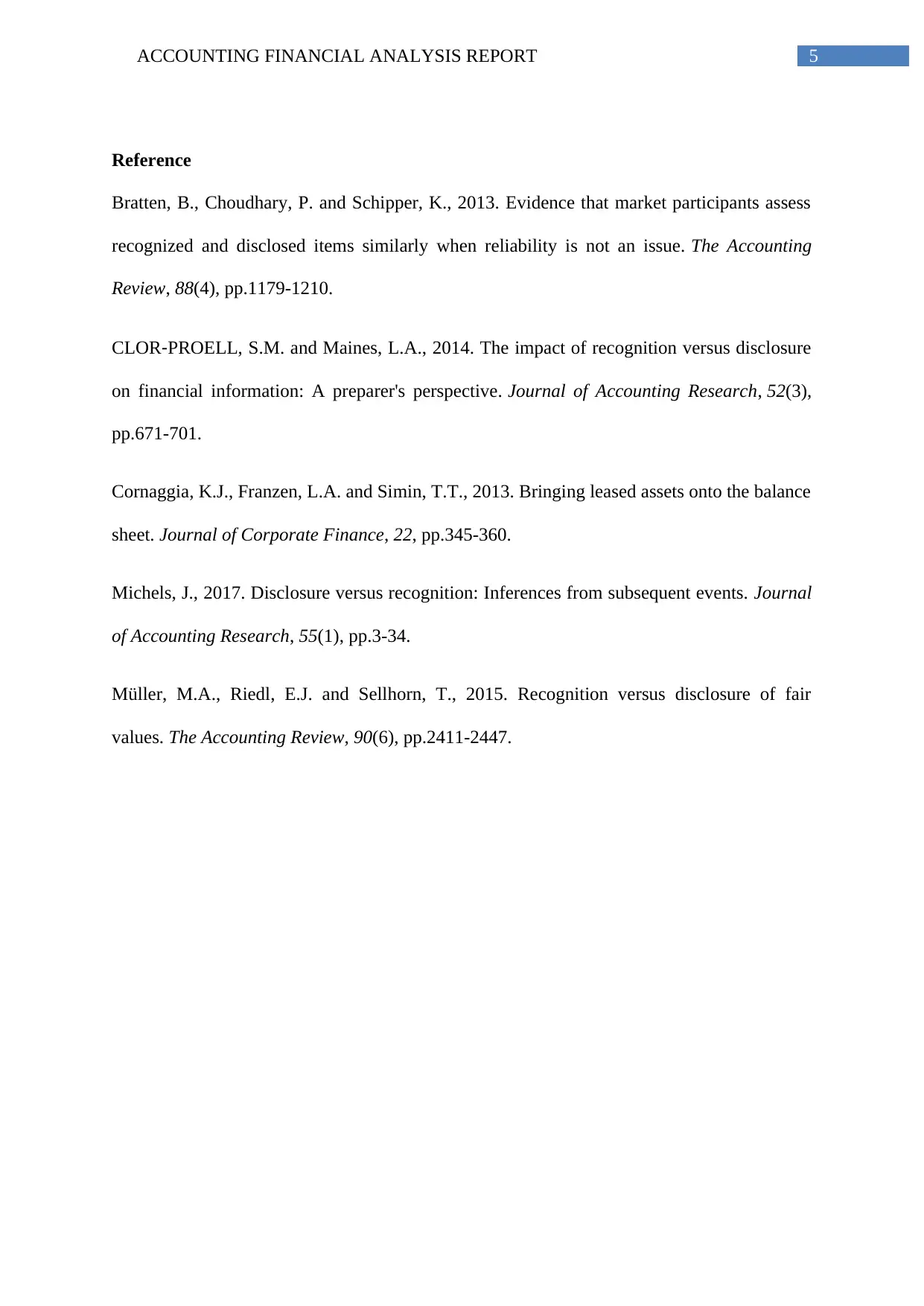
5ACCOUNTING FINANCIAL ANALYSIS REPORT
Reference
Bratten, B., Choudhary, P. and Schipper, K., 2013. Evidence that market participants assess
recognized and disclosed items similarly when reliability is not an issue. The Accounting
Review, 88(4), pp.1179-1210.
CLOR‐PROELL, S.M. and Maines, L.A., 2014. The impact of recognition versus disclosure
on financial information: A preparer's perspective. Journal of Accounting Research, 52(3),
pp.671-701.
Cornaggia, K.J., Franzen, L.A. and Simin, T.T., 2013. Bringing leased assets onto the balance
sheet. Journal of Corporate Finance, 22, pp.345-360.
Michels, J., 2017. Disclosure versus recognition: Inferences from subsequent events. Journal
of Accounting Research, 55(1), pp.3-34.
Müller, M.A., Riedl, E.J. and Sellhorn, T., 2015. Recognition versus disclosure of fair
values. The Accounting Review, 90(6), pp.2411-2447.
Reference
Bratten, B., Choudhary, P. and Schipper, K., 2013. Evidence that market participants assess
recognized and disclosed items similarly when reliability is not an issue. The Accounting
Review, 88(4), pp.1179-1210.
CLOR‐PROELL, S.M. and Maines, L.A., 2014. The impact of recognition versus disclosure
on financial information: A preparer's perspective. Journal of Accounting Research, 52(3),
pp.671-701.
Cornaggia, K.J., Franzen, L.A. and Simin, T.T., 2013. Bringing leased assets onto the balance
sheet. Journal of Corporate Finance, 22, pp.345-360.
Michels, J., 2017. Disclosure versus recognition: Inferences from subsequent events. Journal
of Accounting Research, 55(1), pp.3-34.
Müller, M.A., Riedl, E.J. and Sellhorn, T., 2015. Recognition versus disclosure of fair
values. The Accounting Review, 90(6), pp.2411-2447.
⊘ This is a preview!⊘
Do you want full access?
Subscribe today to unlock all pages.

Trusted by 1+ million students worldwide
1 out of 6
Related Documents
Your All-in-One AI-Powered Toolkit for Academic Success.
+13062052269
info@desklib.com
Available 24*7 on WhatsApp / Email
![[object Object]](/_next/static/media/star-bottom.7253800d.svg)
Unlock your academic potential
Copyright © 2020–2025 A2Z Services. All Rights Reserved. Developed and managed by ZUCOL.




